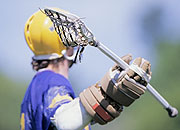
MONDAY, April 18 (HealthDay News) — With another season of warm-weather sports under way, experts are cautioning that many parents don’t take sports injury prevention seriously enough — that they consider commonplace sprains, bruises and pulled muscles “just part of the game.”
About 10 percent of the 38 million American kids participating in sports each year are treated for a sports-related injury, but the U.S. Centers for Disease Control and Prevention estimates that about half these injuries are preventable.
Nonetheless, in a recent national survey sponsored by Safe Kids USA and Johnson & Johnson, 86 percent of the parents surveyed said their child’s injury was “just part of the game” and probably would have happened anyway.
The national telephone survey of 751 mothers and fathers who had at least one child aged 5 to 14 playing popular sports found parents generally expressed little concern about the number of potential injuries their kids could sustain playing team sports, with only concussions and dehydration causing “a great deal” or “quite a bit” of worry.
The most prevalent injuries — sprains, pulled muscles, bruises, broken bones and lacerations — caused little consternation in the parents surveyed.
And only 9 percent of fathers polled were likely to say the injury could have been prevented, compared to 17 percent of the mothers.
The survey, conducted by Hart Research Associates on behalf of Safe Kids USA, also revealed that about 25 percent more children participate in two or more team sports compared to a decade ago, with nearly a third playing multiple sports in a single season.
The survey was a follow-up to similar research done in 2000 that studied parents’ knowledge, attitudes and behaviors on youth sports safety.
“The numbers are telling,” Kyle Johnson, director of communications and marketing for Safe Kids Worldwide, said at Monday news conference unveiling the survey’s results. “About 40 percent of traumatic brain injuries to kids are sports-related … and the direct medical costs are about $11 billion annually.”
Children involved in team sports spend an average of 7.4 hours each week practicing or playing in games, with boys spending about 20 percent more time than girls, and 10- to 14-year-olds spending significantly more time than 5- to 9-year-olds.
Surveyed sports included football, soccer, field hockey, basketball, gymnastics, ice hockey, lacrosse, baseball, softball and T-ball.
One of the easiest problems to prevent is dehydration, said Tanya Chin Ross, director of public policy for Safe Kids USA.
“It’s very important that parents and coaches don’t wait until a child says they’re thirsty,” Ross said, noting that young athletes should drink several ounces of water or sports drinks every 30 minutes.
The survey also found parents and coaches more knowledgeable about injuries and prevention than a decade ago, although it did reveal wide gaps. For example, most parents believe coaches should be well-informed about injury prevention, but at the same time only 29 percent believe their kids’ coaches actually have that knowledge.
Still, parents appear to know somewhat more about sports injuries than a decade ago, with 61 percent (vs. 51 percent in 2000) recognizing that more injuries occur during practices than games. Children, coaches and parents are also more likely to take multiple precautions to minimize injuries than they were 11 years ago, the study found.
However, the number of young athletes sustaining multiple injuries in team sports has increased to nearly 1.5 times the 2000 levels, a rise due almost entirely to higher rates of injuries among 10- to 14-year-old girls. Girls in this age group are now being injured at a rate equal to boys of the same age, the survey noted.
Lack of knowledge and concern about overuse injuries was also prevalent, the survey found.
Experts speaking at the Safe Kids news conference said the survey didn’t explain the jump in injuries among pre-adolescent girls. But, other research indicates females in this age group are four times to eight times more likely than boys to tear the anterior cruciate ligament in their knee, which is essential to knee stability.
“This is an area that bears much more research,” said Angela Mickalide, director of research and programs for Safe Kids Worldwide. “We really must do more to stop this trend.”
Nearly all parents surveyed felt organized team sports provide positive experiences for their children, and 31 percent said learning values such as teamwork and sportsmanship was the most important benefit.
Mickalide cautioned, however, that parents should not place undue pressure on their children to succeed in sports, noting that less than 1 percent of kids ever advance to the professional level.
More information
To learn more about children and sports safety, visit the U.S. National Institutes of Health.

